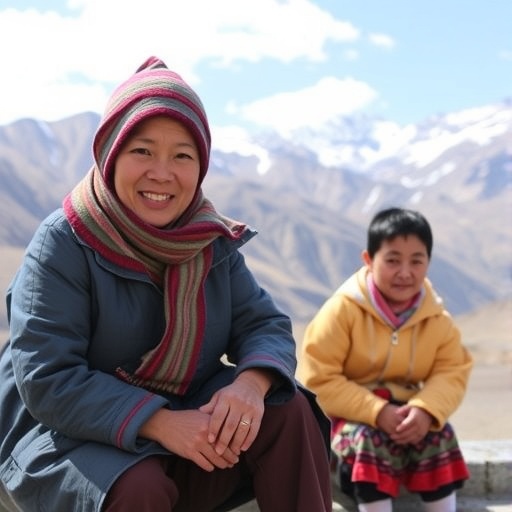Amidst the soaring peaks of the Tibetan Plateau, researchers are unveiling a critical discourse surrounding healthcare accessibility and its profound implications on subjective well-being. As one of the highest altitude regions in the world, Xizang, also known as Tibet, presents a unique context for understanding the intersection of geography, culture, and health services. In a groundbreaking study led by Li et al., the intricate dynamics of healthcare provision in this challenging terrain are unpacked, offering enlightening insights into the lives of its inhabitants and their psychological states.
The study meticulously explores how geographic isolation and limited healthcare facilities in Xizang directly correlate with the residents’ perceptions of well-being. It posits that access to health services dramatically influences life satisfaction, emotional health, and social stability. Participants in this region encounter a plethora of hurdles, including limited transportation options, a scarcity of medical professionals, and inadequate infrastructure, all of which exacerbate their health-related stressors. This dissection of the geographic and systemic barriers faced by the locals evokes a sense of urgency towards ameliorating healthcare policies in high-altitude regions.
The research team employed a mixed-methods approach, encompassing qualitative interviews alongside quantitative surveys, to gauge healthcare accessibility and subjective well-being among the population. This dual methodology ensured that the data reflects not just statistical numbers but the human experience and emotional landscape of people living in these remote areas. Through the voices of the residents, the pervasive sense of isolation emerges, which has implications not only for their physical health but also for their mental and emotional wellness.
One of the standout findings of this investigation is the observation that any improvement in health service accessibility directly corresponds to heightened levels of life satisfaction among the locals. This correlation underscores the fundamental principle that healthcare is not merely a service but a crucial pillar supporting mental health and social cohesion. Communities that experience increased access to healthcare resources report significantly lower levels of anxiety and improved social interactions, reinforcing the innate human need for connectivity and care in times of distress.
Delving deeper into the study, it becomes evident that cultural factors interplay significantly with healthcare access. In Xizang, traditional beliefs and values may shape individuals’ willingness to seek modern medical assistance, often leading them to rely on local healers. While these traditional practices carry weight in the community, the challenge remains in blending these with modern healthcare approaches to create a comprehensive system that meets the diverse needs of the residents. This calls for policymakers to engage with local customs to create more acceptable healthcare solutions.
Moreover, the environment in Xizang introduces unique health challenges, such as altitude sickness, which can complicate access to care. The physiological stresses that accompany high-altitude living cannot be understated; they compound the existing issues related to healthcare accessibility. This backdrop sets the stage for a deeper understanding of how environmental and systemic factors together mold the wellness trajectories of the population. It emphasizes the need for targeted healthcare interventions that respect local conditions and culture while adequately addressing medical shortcomings.
The psychological ramifications of healthcare accessibility in this high-altitude region extend beyond individual well-being; they ripple through entire communities. A consistent lack of medical resources can foster feelings of hopelessness and anxiety, leading residents to develop a resigned attitude towards their health. Conversely, communities that enjoy better access to healthcare not only report improvements in individual health outcomes but also demonstrate enhanced social resilience, showcasing the community’s ability to support each other in times of need.
Policy implications stemming from this research are significant. By synthesizing the insights gathered from the Tibetan Plateau, it becomes clear that targeted interventions and investments in healthcare infrastructure are imperative. This should not only include the development of physical healthcare facilities but also the training and retention of medical professionals who understand the unique challenges faced by local populations. Emphasizing continuity of care and accessibility can serve as a catalyst for improvement in overall life satisfaction in these areas.
Furthermore, the study advocates for a more integrated approach between traditional and modern healthcare systems. Engaging local healers within the broader healthcare framework can facilitate a more holistic model that acknowledges and respects the cultural context while providing comprehensive health solutions. Developing community health programs that leverage local wisdom and practices could be a transformative step towards enhancing health outcomes and overall well-being.
In alignment with the study’s findings, public health campaigns focused on the promotion of mental health support in the region are also essential. The mental health ramifications of consistently navigating an inadequate healthcare landscape can be profound. Creating a supportive environment that nurtures emotional wellness can prove to be just as critical as improving physical healthcare access. Initiatives centered around mental health resources can proliferate resilience and offer residents strategies for coping with their environmental and systemic challenges.
As the world grapples with the ongoing ramifications of inequitable healthcare access, the insights gleaned from Xizang stand as a poignant reminder. They illustrate the necessity of viewing health through a multi-dimensional lens, incorporating not just biological factors, but also psychological and social determinants of health. Addressing the voids in healthcare accessibility can significantly uplift the subjective well-being of individuals, fostering thriving communities even in the face of adversity.
The echoes of Xiang global implications are potent, lending voice to a conversation that transcends borders. With healthcare accessibility being a universal necessity, similar studies in varied contexts can be instrumental in advocating for policy shifts that prioritize human well-being as a fundamental right. This research can set a precedent for other high-altitude and remote regions around the world, igniting a revolution in how communities approach health, accessibility, and overall happiness.
As we look towards the future, the call for concerted global efforts to bridge the healthcare accessibility gap is louder than ever. The findings presented by Li et al. serve as a powerful rallying point for activists, policymakers, and healthcare professionals alike. Through collaborative action, there is an opportunity to alter the narrative surrounding healthcare accessibility and subjective well-being, not only in Xizang but in high-altitude regions worldwide.
In conclusion, the revelations from this research resonate beyond academic walls; they penetrate the very fabric of societal wellbeing. The conscious interlinking of healthcare accessibility with subjective well-being in Xizang opens new avenues for exploration and action, reminding us that health is more than an absence of illness—it’s a multifaceted endeavor requiring societal investment, cultural understanding, and an unwavering commitment to equity in health services.
Subject of Research: Healthcare accessibility and subjective well-being in Xizang: evidence from a high-altitude region of China.
Article Title: Healthcare accessibility and subjective well-being in Xizang: evidence from a high-altitude region of China.
Article References:
Li, C., Wu, X., Lacuo, Y. et al. Healthcare accessibility and subjective well-being in Xizang: evidence from a high-altitude region of China.
BMC Health Serv Res 25, 1447 (2025). https://doi.org/10.1186/s12913-025-13597-6
Image Credits: AI Generated
DOI: https://doi.org/10.1186/s12913-025-13597-6
Keywords: Healthcare accessibility, subjective well-being, Xizang, high-altitude regions, health policy.
Tags: cultural impact on health servicesemotional health in high-altitude regionsgeographic barriers to healthcarehealthcare access in Xizanghealthcare disparities in Tibethealthcare infrastructure challengeshealthcare policies for remote areasmixed-methods research in healthcarepsychological well-being in Xizangsubjective well-being and healthtransportation issues in healthcare accesswell-being in Tibetan Plateau





